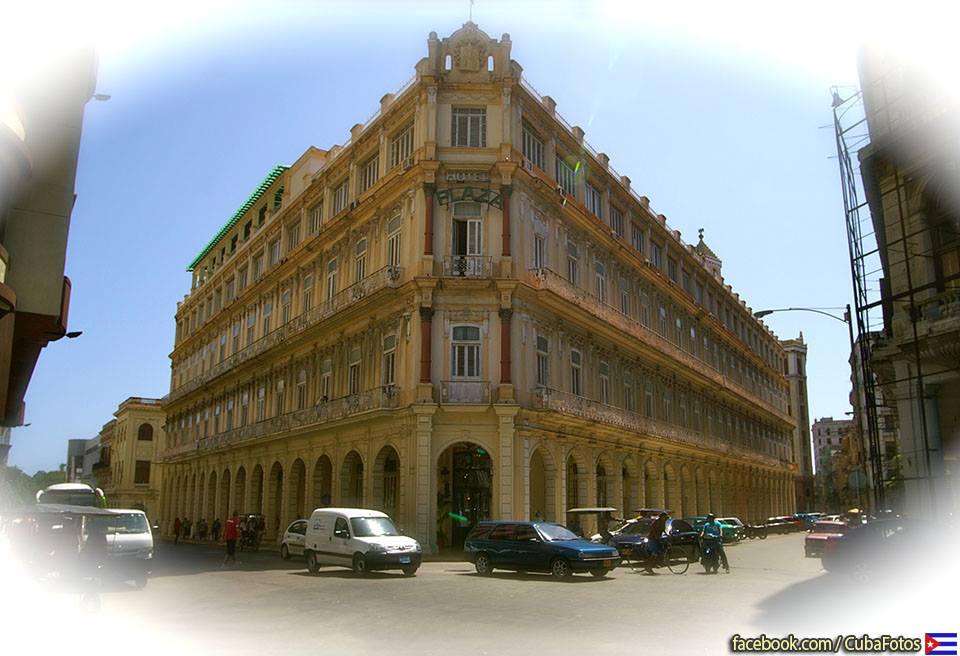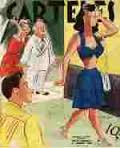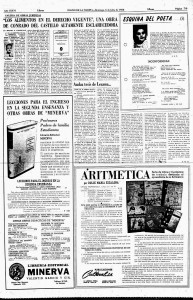DE CUANDO LA HABANA PERDIÓ SU PROJECTOR. MEMORIAS.
Cuando los periódicos eran aún una industria floreciente y La Habana tenía una veintena de diarios de amplia circulación, un periódico comunitario del barrio de Los Pinos llamado ‘Proyector’ vivía también su época más luminosa.
Han pasado más de cinco décadas desde que la prensa cubana abandonó su papel de catalejo social y comenzó a ser instrumento de propaganda y conducción política de los ciudadanos, pero merece mirar atrás y reconocer la vitalidad del sistema informativo y la proliferación de periódicos que circulaban en Cuba antes de la llegada al poder de Fidel Castro.
El primer número de Proyector, emitido el 15 de diciembre de 1940, pasó inadvertido para la mayoría de los pobladores del actual municipio de Arroyo Naranjo, que en aquel momento era mencionado como el “Chicago habanero” por lo tradicional de sus edificaciones, el floreciente comercio y el control de sus calles por alguno que otro lugarteniente de la mafia, proveniente de esa metrópoli estadounidense.
William Pupo Sagoyner, un joven periodista de ascendencia catalana y que había sido despedido del Diario de la Marina, emprendió la tarea de editar un periódico por su propia cuenta. Con la ayuda de su hermano Wilder y su esposa América, puso el sentido de pertenencia al barrio como su principal escudo, y los ahorros como empeño para tener los suficientes materiales de producción.
..En 1943 la popularidad local de Proyector alcanzó niveles impresionantes, al punto de contar ya con sólidas secciones de noticias sociales, deportivas, culturales y políticas. Estas últimas fueron responsables de varios debates con el Congreso nacional, los cuales reportaron dividendos positivos para la localidad. Para esa época el periódico tenía ya una tirada superior a los dos mil ejemplares.
“Proyector era el lugar donde todo el mundo quería aparecer y denunciar sus problemas, porque vieron que así tenían alguna solución. La Asociación de Propietarios y Vecinos siempre se `ponía para las cosas´ cuando salía algo fuerte. Incluso hubo un dilema de los editores con el Congreso sobre fondos para la unión de la carretera entre Los Pinos y el reparto Poey que terminó con la ampliación de la calle Perla en 1944”, rememoró Herminia Solaya, una anciana octogenaria que en algún momento de su adolescencia colaboró con el periódico en los temas estudiantiles y con entrevistas a señoritas de sociedad.
Casi todos los entonces habituales lectores de Proyector han fallecido, pero aún hoy se pueden encontrar algunos ejemplares ya bañados por el tono amarillento que imprime el tiempo. Como múltiples empresas periodísticas, fue acallado en horas tempranas de la revolución, luego de que en 1961 el gobierno ordenara su cierre con la nueva Ley de Prensa que ilegalizaba toda publicación que estuviese fuera del sistema oficial.
“Mi abuelo siempre se lamentaba por la forma en que le destruyeron su obra y Los Pinos ahora es un barrio más entre los desbaratados suburbios habaneros, porque no tiene a nadie que lo defienda, así que todos perdimos”, apuntó Pupo Sánchez, nieta del fundador del periodico.
El gobierno cubano cuenta con el monopolio de los medios de comunicación y por ende de sus líneas editoriales. En la capital circulan los tres periódicos de tirada nacional (Granma, Juventud Rebelde y Trabajadores), además del semanario provincial Tribuna de La Habana, así como alrededor de una decena de revistas como la centenaria Bohemia, de exigua presencia hoy en los puntos de venta.
Mientras la radio cuenta con cinco emisoras nacionales -Radio Rebelde, Progreso, Taíno, Reloj y Enciclopedia- y las ondas locales son llenadas con Radio COCO, Metropolitana, Ciudad y Cadena Habana. Los televisores habaneros cuentan con los cinco canales de impacto general: Cuba Visión, Tele Rebelde, Multi Visión, Educativo 1 y 2, además del Canal Habana en las ondas restringidas.
Pero ningún medio posee capital privado u objetivos editoriales independientes, lo cual está prohibido por las leyes vigentes. La Constitución socialista, aprobada en 1976 y ratificada en 1992, indica que “la prensa, la radio, la televisión, el cine y otros medios de difusión masiva son de propiedad estatal o social y no pueden ser objeto, en ningún caso, de propiedad privada”.
La libertad que llevó a Proyector a impactar en su comunidad aún queda flotando por las calles e imprentas cubanas, con la ilusión de recuperar alguna vez su luz propia.
CafeFuerte/Daniel Palacios/Excerpts/InternetPhotos/TheCUbanHistory.com
THe Cuban History, Hollywood.
Arnoldo Varona, Editor.
Hotel Plaza, Habana Vieja. Cuba en Fotos.

WHEN LA HAVANA LOST ITS PROJECTOR. MEMORIES.
When newspapers were still a thriving industry and Havana had a dozen mainstream newspapers, a community newspaper of the Los Pinos neighborhood called ‘Projector” (Spotlight) also lived its brightest era.
It has been over five decades since the Cuban press abandoned its role of social telescope and began to be an instrument of propaganda and political citizens driving but should look back and recognize the vitality of the information system and the proliferation of newspapers circulating in Cuba before coming to power of Fidel Castro.
The first issue of the Projector” (Spotlight), issued on December 15, 1940, went unnoticed by most people of the present municipality of Arroyo Naranjo, who at that time was referred to as the “habanero Chicago” for tradition of its buildings, the burgeoning trade and control of its streets occasional mafia lieutenant, from the American metropolis.
William Pupo Sagoyner, a young journalist Catalan descent and had been dismissed from the Diario de la Marina, undertook the task of editing a newspaper on their own. With the help of his brother and his wife America Wilder, put the sense of belonging to the neighborhood as the main shield, and the savings as hard to have enough materials for production.
In 1943 local .. Popularity Projector reached impressive levels to the point of already having solid sections of social, sporting, cultural and political news. The latter were responsible for several discussions with the National Congress, which reported positive dividends for the locality. By that time the newspaper already had over two thousand copies shot.
“Spotlight was where everyone wanted to come and report their problems, and they saw that they had a solution. The Homeowners ‘Association `always wore to things’ as he left something strong. There was even a dilemma publishers with Congress over funding for the union of the road between Los Pinos and Poey deal that ended the expansion of Pearl Street in 1944, “recalled Solaya Herminia, an octogenarian old woman at some point in his teens worked with the student newspaper and interviews with issues of society ladies.
Almost all regular readers Projector then have died, but even today you can find some copies already bathed in yellowish printing time. As many media companies, was silenced in the early hours of the revolution, in 1961 after the government ordered its closure with the new press law outlawing any publication that was outside the official system.
“My grandfather always lamented how he destroyed his work and now Los Pinos is a suburban neighborhood between Havana thwarted because he has no one to defend him, so all we lost,” Pupo said Sanchez, granddaughter of founder of the newspaper.
The Cuban government has a monopoly on the media and therefore of their editorial lines. In the capital circulate the three national newspapers (Granma, Juventud Rebelde and Trabajadores), besides the provincial weekly Tribuna de La Habana, as well as about a dozen magazines as the century Bohemia, today small presence in retail outlets .
While the radio you have five national radio stations-Radio Rebelde, Progress, Taíno, and Encyclopedia Clock-and local waves are filled with COCO Radio, Metropolitan, City and Havana brand. Habaneros TVs have five channels overall impact: Cuba Vision, Tele Rebelde, Multi Vision, Education 1 and 2, plus Channel Havana in restricted waves.
But private equity has no media or independent editorial objectives, which is prohibited by applicable law. Socialist Constitution, adopted in 1976 and ratified in 1992, states that “the press, radio, television, film and other mass media are state or social property and can not be, in any case, property private “.
The freedom that led the “Projector” to impact its community is still floating in the streets and Cuban presses, with the hope of ever recovering their own light.
CaféFuerte / Daniel Palacios / Excerpts / InternetPhotos / TheCUbanHistory.com
THe Cuban History, Hollywood.
Arnoldo Varona, Editor



 WHEN LA HAVANA lost its projector. Memories. (Photos) ** LA HABANA pierde su Proyector.
WHEN LA HAVANA lost its projector. Memories. (Photos) ** LA HABANA pierde su Proyector.




